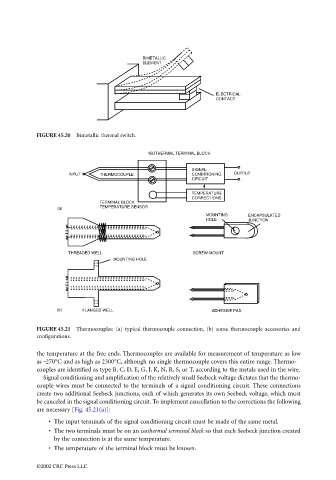Page 1180 - The Mechatronics Handbook
P. 1180
BIMETALLIC
ELEMENT
ELECTRICAL
CONTACT
FIGURE 45.20 Bimetallic thermal switch.
ISOTHERMAL TERMINAL BLOCK
SIGNAL
INPUT THERMOCOUPLE CONDITIONING OUTPUT
CIRCUIT
TEMPERATURE
CORRECTIONS
TERMINAL BLOCK
(a) TEMPERATURE SENSOR
MOUNTING ENCAPSULATED
HOLE JUNCTION
THREADED WELL SCREW-MOUNT
MOUNTING HOLE
(b) FLANGED WELL ADHESIVE PAD
FIGURE 45.21 Thermocouples: (a) typical thermocouple connection, (b) some thermocouple accessories and
configurations.
the temperature at the free ends. Thermocouples are available for measurement of temperature as low
as -270°C and as high as 2300°C, although no single thermocouple covers this entire range. Thermo-
couples are identified as type B, C, D, E, G, J, K, N, R, S, or T, according to the metals used in the wire.
Signal conditioning and amplification of the relatively small Seebeck voltage dictates that the thermo-
couple wires must be connected to the terminals of a signal conditioning circuit. These connections
create two additional Seebeck junctions, each of which generates its own Seebeck voltage, which must
be canceled in the signal conditioning circuit. To implement cancellation to the corrections the following
are necessary [Fig. 45.21(a)]:
• The input terminals of the signal conditioning circuit must be made of the same metal.
• The two terminals must be on an isothermal terminal block so that each Seebeck junction created
by the connection is at the same temperature.
• The temperature of the terminal block must be known.
©2002 CRC Press LLC

